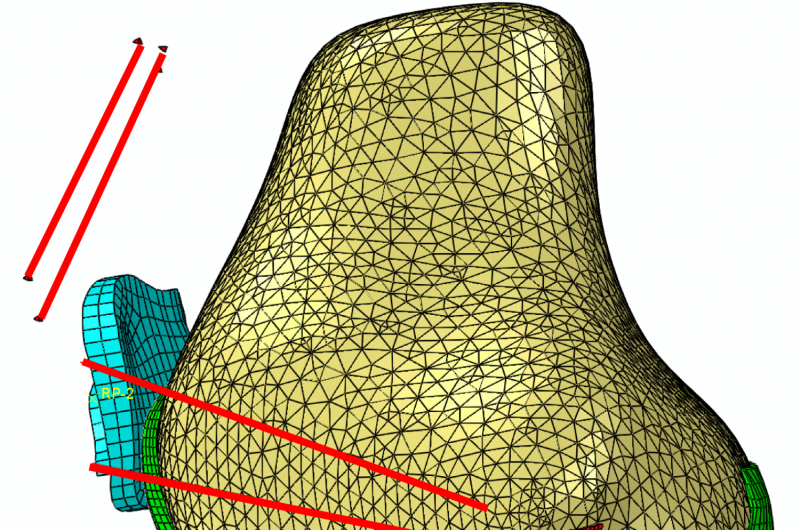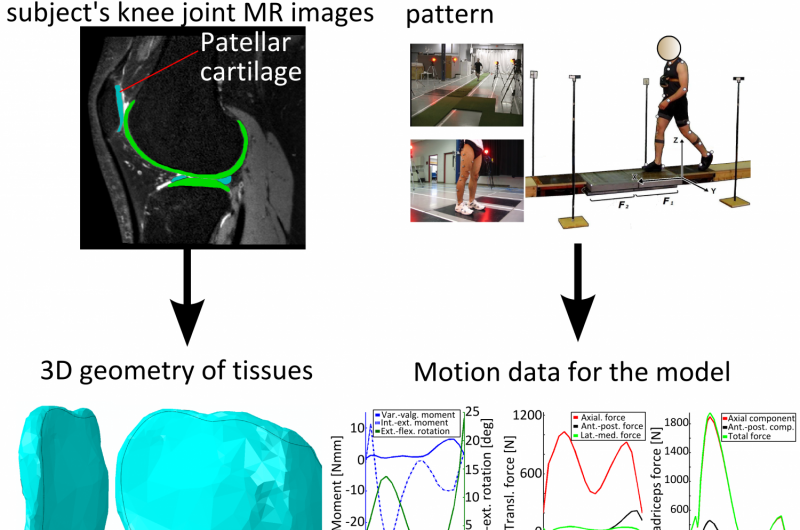Graft properties affect knee ligament surgery outcome more than surgical technique

In anterior cruciate ligament (ACL) reconstruction, graft stiffness and pre-strain play a more vital role than the choice of surgical technique, indicates a new study from the University of Eastern Finland. The study developed a computational 3D model of the knee joint, which can be used in the prevention of osteoarthritis (OA), specifically OA resulting from trauma.
OA is a major burden to society. It is estimated that over 100 million people suffer from OA in Europe alone, and the probability to develop OA is over 50% in people over the age of 60. OA is most common in knee and hip joints. The disease is believed to mainly result from mechanical stress to the articular cartilage, which may be a result of natural wear in the joint or from a trauma incident. OA causes pain and hinders the joint's movement and function and, in the late stages, requires a total joint replacement. OA in the knee is also common in many athletes who have suffered injuries to the ACL or menisci, which are important tissues in the knee joint. What makes these incidents problematic is the fact that the patient has a high chance of post-traumatic OA regardless of whether the ligament is repaired surgically or not.
The study used magnetic resonance imaging to produce 3D objects of the bones, cartilages and other tissues in the knee. These 3D objects were given their respective material parameters, which have been previously validated experimentally. The study developed a material model of the articular cartilage, and validated its response to loading by imaging the subject's knee during loading and motion. Finally, the validated model was applied to a situation where the subject's ACL was ruptured and then repaired using different techniques and grafts.
Graft stiffness equal to healthy ACL restored knee function best
In the knee joint model, the simulated ACL rupture increased anterior tibial translation and interior tibial rotation, which is exactly the phenomenon observed in ACL deficient patients. Even though a rupture in the ACL reduced the average forces the cartilage experiences, local peak forces could be increased, which may explain why post-traumatic OA develops. Two of the most commonly used ACL reconstruction techniques, the single bundle and the double bundle reconstruction, did not produce significantly different results in terms of both the knee motion and the stresses and strains the cartilage experiences. Because of the stiff graft, both reconstruction techniques increased the average forces the knee joint experiences, which may explain why most patients with a reconstructed ACL still develop OA. The model with the graft stiffness equal to that of a healthy ACL restored the knee function the best, in terms of both knee motion and cartilage stresses. The next best match with the healthy model was provided by the model with the reduced graft pre-strain.

The results of the study indicate that the material properties and optimal pre-tensioning of the graft may determine the outcome of an ACL reconstruction surgery.
"The challenge comes from the fact that on one hand, the selection of tissues that can be used as autograft is very limited. Currently, doctors either make the graft from patellar tendon (below the knee cap) or tendons behind the thigh, and both are over twice as stiff as a healthy ACL. On the other hand, the graft is known to loosen soon after the surgery. The ultimate goal of this research is to provide medical doctors with a diagnostic tool that could help evaluate the effect of surgical procedures on the knee joint function, before and after the surgery," says researcher Kimmo Halonen. The findings were originally published in Journal of Biomechanics, and some are currently pending publication.
More information: K S Halonen et al. Importance of depth-wise distribution of collagen and proteoglycans in articular cartilage—A 3D finite element study of stresses and strains in human knee joint, Journal of Biomechanics (2013). DOI: 10.1016/j.jbiomech.2012.12.025
K.S. Halonen et al. Deformation of articular cartilage during static loading of a knee joint – Experimental and finite element analysis, Journal of Biomechanics (2014). DOI: 10.1016/j.jbiomech.2014.04.013
















